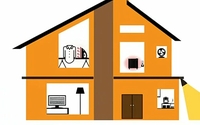Commentary
Smart Homes Growing to 339 Million Next Year
- by Chuck Martin , Staff Writer, December 7, 2015
 At year end, all the forecasts for the
next several years come rolling in and The Internet of Things is heavy in the mix, as might be expected.
At year end, all the forecasts for the
next several years come rolling in and The Internet of Things is heavy in the mix, as might be expected.
The five-year forecasts generally have the number of connected objects skyrocketing, the widespread adoption of smart everything and billions of sensors of various types pretty much everywhere.
While many of these forecasts can be useful indicators for long-term strategic planning in an organization, five years from now not many people are likely to look back to check the accuracy of these forecasts.
Meanwhile, many brands and marketers are looking to figure out what they should do for just the next year so they can plan and budget accordingly,
The reality is that IoT growth won’t all happen in five years; it is exploding year to year.
For example, there are 174 million smart homes this year, according to a new report from Gartner. But the number of smart homes will almost double next year, to 339 million.
The consumer applications fueling the growth of smart homes are smart TVs, smart set-top boxes, smart bulbs and various automation tools, such as smart thermostats, home security systems and kitchen appliances, according to Gartner.
Overall, the total number of connected things is expected to hit 1.6 billion, up from 1.2 billion this year.
Smart homes are but one aspect of smart cities, which include the introduction of connected devices in transportation, utilities and commercial buildings, such as the new one with 8,000 smart lights in New York being constructed for agency R/GA.
Consumers will have access to connectivity wherever they go. This is a step way beyond mobile, since the objects will be communicating with each other, with the expectation that new value will be created for consumers in motion
The critical link will be the messaging and content that will have to be created to leverage all those connections.
And that’s what brands and agencies should be building into their plans for the next year.




See related info on how to help protect the smart home and re-provision it when sold or purchaszed https://otalliance.org/SmartHome
Your article doesn't seem to say that the numbers cited by Gartner must be global, as there are only 123 million households in the United States. Also, it appears that Gartner's definition of a 'smart home' is 'a home with at least one non-computing device connected to the internet'. While that's a number worth tracking, the more useful definition of a smart home might be one in which devices interact with one another, whether through a local or wide-area network, to benefit the occupants. The fact that my TV can call up Netflix directly is a nice feature, but I don't think it means I live in a 'smart home'.
That Gartner stats are glonbal, as they often are, Brian. The stats often refer to smart objects in a home rather than an entirely connected home.
Thanks, Craig, had seen your link on an earlier comment.